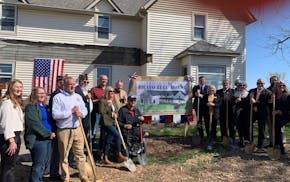Even now, with fall rushing toward winter, the handsome gardens along Rushmore Drive in Burnsville draw the eye with their maroon sedums, purple asters and waving ornamental grasses.
All the gardens are near the curb, and all drop a foot or two below street level at their lowest point.
They're rain gardens.
Since they were planted in 2003, they've attracted national attention for their success in diverting storm water that would have gone directly into a local lake. About 90 percent of the water that flows off Rushmore Drive now filters into the ground instead, trapping debris and pollutants.
Bloomington is now trying to replicate some of that success with a street reconstruction project along two blocks of Thomas Avenue South that normally dump storm water into Nine Mile Creek. Curb cuts will direct storm water instead into six large rain gardens in private yards. Maplewood, Plymouth, Arden Hills, St. Paul Park and Stillwater have undertaken similar projects, and Lake Elmo is planning one next year.
The idea is not to handle all storm water through rain gardens -- even streets with rain gardens have storm sewer grates to take in overflow -- but to use them as another weapon in the arsenal to prevent water that carries fertilizer, oil from the street, grass clippings and debris from directly entering lakes and streams.
In Bloomington's case, a $25,000 grant from the Nine Mile Creek Watershed District is paying about half the cost of installing the rain gardens, with the city's storm water utility fund paying the rest.
"It was a way to get residents involved in storm water treatment in a way that would be fun," said Steve Segar, a Bloomington civil engineer who works on water resources. "We wanted to start on a smaller scale, because this is the first time we've done this. But we hope to include it in future street reconstruction."
Richard Schrieber is one of the Thomas Avenue homeowners who will be planting his rain garden at the end of the month. The garden in his front yard will measure about 10 feet by 30 feet and will feature a retaining wall on one side.
"Aesthetically, it's going to look nice," he said. "It's going to do something good for the environment. It's not going to cost me anything. And the more grass they take, the less I have to mow."
How they work
Rain gardens that divert storm water from streets use curb cuts to direct water into the gardens.
The depth of the garden is determined by how quickly the soil absorbs water. Native plants with deep roots help absorb the water and need limited care. In Burnsville, a strip of grass between curb cuts and gardens catches leaves and other debris that can just be raked up. Bloomington is trying a few different ways to catch sediment and debris, one using underground pipes and another with a grate that can be vacuumed out.
Twenty-two homeowners on Thomas Avenue had yards that fit the criteria for rain gardens, but only six accepted, Segar said. While he admitted that was disappointing -- the installation is more expensive without the economies of scale of a larger project -- he said the gardens still give the city a mini-laboratory to see how well they work.
Residents will be responsible for maintenance, and the gardens will have to be weeded, especially during the first two years. Schrieber isn't thrown by that. "If you have any pride in your yard, it's just something you do," he said.
Bruce Corzine, one of 17 Burnsville homeowners who have rain gardens along Rushmore Drive, said he's not a gardener but spends maybe eight hours a year weeding and cutting back plants.
"It really depends on how much weeding you want to do," Corzine said. "We lost a few plants and had to replant some roses that had grown too close to the street. ... I like it. It's nice to be able to look out the window and see not just grass."
The Burnsville project cost almost $150,000, partly because the project modified an existing street and was done at a time when rain gardens were still rare. Rusty Schmidt, a rain garden expert with the Washington Conservation District in Stillwater, said building rain gardens is cheaper when it's done as part of street reconstruction. He said that though rain gardens are just one small part of the storm water puzzle, they're becoming more important as cities find they don't have room for giant storm water ponds.
In Maplewood, rain gardens have been a standard part of street reconstruction since 1999. The city now has more than 500 rain gardens in yards and more than 30 on city property.
"We've learned so much over the years," said Ginny Gaynor, the city's natural resources coordinator. Maplewood, which supplies plants and digs the gardens for homeowners, offers 10 different garden designs for residents, who plant and maintain the gardens.
Every couple of years the city offers "weed consults" to homeowners, a service that 10 percent of them used last year.
Gaynor said she isn't sure if the gardens ultimately save money. But she said if the city can meet its watershed district requirement to infiltrate one inch of rain on street projects partly with rain gardens, more expensive underground storm water systems don't need to be built.
"Our goal is always to do as many gardens as we can in a boulevard," she said.
Mary Jane Smetanka • 612-673-7380

Overdose deaths spike after incarceration, but Minnesota jails lack treatment

New sober house for veterans in southern Minnesota wants to treat the real issue: PTSD
Two North Loop condos combined into one 'dreamy' space listed for $649,900

